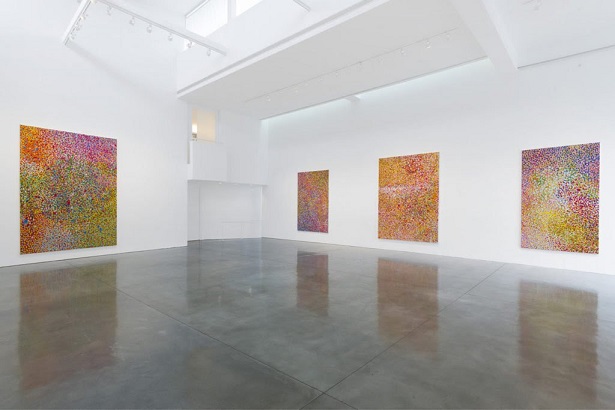“Damien Hirst: The Veil Paintings,” installation view at Gagosian Beverly Hills. Artworks ©Damien Hirst and Science Ltd. All rights reserved, DACS 2018. Photo by Jeff McLane.
But several Australian artists and dealers maintain that the works also appear indebted to a community of indigenous female artists in Utopia, Australia, near Alice Springs. “The Utopia painting style is unique to their desert tradition and rendered on canvas in the hope young people will learn about their past,” wrote ABC Australia. “The desert dot paintings are often aerial landscapes painted from memory over many painstaking hours.”
The dealer Christopher Hodges, the owner of Utopia Art Sydney, which represented Kngwarreye at the time of her death, told the Guardian the resemblance was “uncanny.”
Nevertheless, Hirst’s representatives say the artist was “unaware” of this work. In a statement provided to the Guardian, a spokeswoman said: “The Veil Paintings are a development of a series Damien made in 1993–1995 called Visual Candy and are inspired by pointillist techniques and Impressionist and post-impressionist painters such as Bonnard and Seurat. Damien was unaware of the work or artist in question, but he has huge respect for the importance of the value of art in all cultures.” (artnet News reached out for further comment, but did not hear back by press time.)
Visitors admire paintings during the opening of Emily Kame Kngwarreye’s exhibition at the National Art Center in Tokyo on May 27, 2008. Photo courtesy of Ken Shimizu/AFP/Getty Images.
In response to the kerfuffle, the New York-based dealer Emerald Gruin is organizing an exhibition at Olsen Gruin gallery featuring the work of Aboriginal artists Kathy Maringka, Polly Ngale, and Gabriella Possum Nungurrayi. Curated by Adam Knight, the president of the Aboriginal Art Association of Australia, and on view from May 16–June 17, 2018, the show aims to highlight the similarity between the abstract painterly style of all three women and Hirst’s “Veil Paintings.”
In interviews leading up to the show, Hirst has repeatedly maintained that this series was personal—as much about his own history as art history. Unlike many of his other series, he painted this one himself, without the help of studio assistants. “I just thought fuck it, I need to go back to my original feelings about color and forget the grid and to hell with order,” he wrote on Instagram.

Emily Kame Kngwarreye, Kame – Summer Awelye II (1991). Courtesy of Sotheby’s London.
The show sold out on opening day, with the canvases going for between $500,000 and $1.7 million, for a reported total of $18 million. In comparison, data from the artnet Price Database indicates that Kngwarreye set a new auction record this month, with the £309,000 ($430,662) sale of Kame – Summer Awelye II (1991) at Sotheby’s London. (An Australian gallery, CooeeArt, claims to have auctioned Kngwarreye’s Earth’s Creation I [1994] for $2.1 million in Australian currency, or $1.59 million, in November.)
“If you like these sort of paintings that Damien Hirst does, you could buy an original Emily Kngwarreye for a lot cheaper than a Damien Hirst painting,” Christopher Hodges told the Guardian. “It’s not just that he used little dots, it also seems that there’s dots within dots, which is one of the things that she did… There’s shifting layers.”

A painting by Aboriginal artist Emily Kame Kngwarreye at Sotheby’s Australia. Photo courtesy of Greg Wood/AFP/Getty Images.
Whether or not you see the resemblance, or believe that it is intentional or coincidental, some in the Australian community are calling for Hirst to give credit to Indigenous artists.
“I was a little bit shocked when I saw [the “Veil Paintings”] ’cause I thought they could have been passed [off] as some Utopian work,” Indigenous artist and Arts Law Centre board member Bronwyn Bancroft told ABC. “[There’s] a moral obligation, I think, on behalf of Damien Hirst, to indicate the influence for this last series of work actually came from an Aboriginal art movement.”
This isn’t the first time Hirst has been accused of some form of artistic plagiarism; similar charges were leveled at the artist during his Venice exhibition, “Treasures of the Wreck of the Unbelievable.” Some critics, including artnet News’s Ben Davis, pointed out that Hirst’s biennale show looked almost exactly like the Grenada Pavilion‘s group presentation, “The Bridge.”
See more examples from Hirst’s “Veil Paintings” series and the work of the Utopia artists below.
Damien Hirst’s Veil of Love Everlasting (2017). Courtesy of Gagosian Gallery. ©Damien Hirst and Science Ltd. All rights reserved, DACS 2018.
Polly Ngale, Anwekety. Courtesy of Utopia Lane Gallery.

Gabriella Possum Nungurrayi, Grand Mothers Country (2017). Courtesy of Olsen Gruin Gallery.

Damien Hirst, Super Happy Happy Dabby (1993), from the “Visual Candy” series, a point of inspiration for his new “Veil Paintings.” Courtesy of Gagosian Gallery, ©Damien Hirst and Science Ltd. All rights reserved, DACS 2018.
 Kathy Maringka, Tjulpuntjulpunpa (2017). Courtesy of Olsen Gruin Gallery.
Kathy Maringka, Tjulpuntjulpunpa (2017). Courtesy of Olsen Gruin Gallery.

Kathy Maringka, Tali Ngura – Sandhill Country (2016). Courtesy of Olsen Gruin Gallery.










